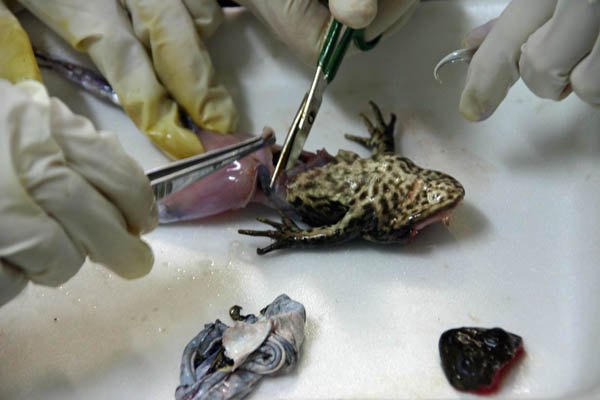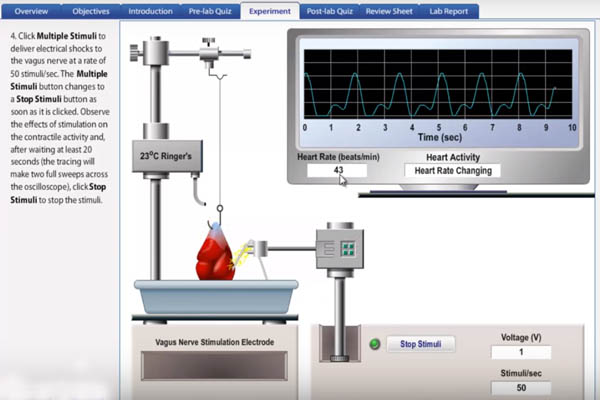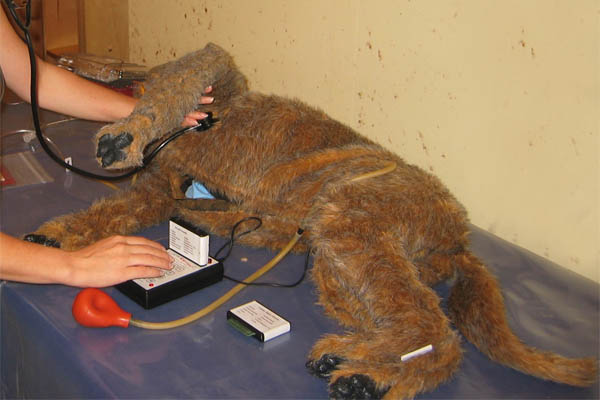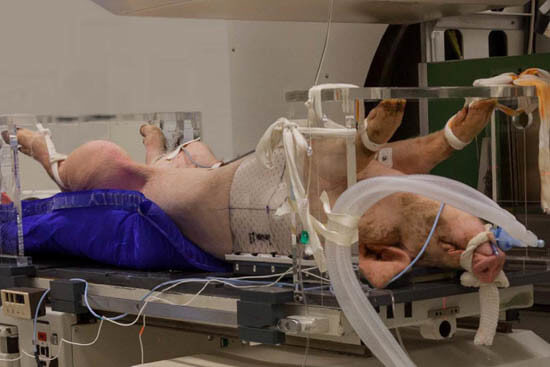Animal experimentation in higher education and animal-free teaching methods
At many universities, so-called animal use* is a compulsory part of the training in the fields of medicine, veterinary medicine, and biology. For students of agricultural and nutritional sciences, pharmacy or psychology, internships with animal use are also sometimes part of the curriculum. Animal experimentation also occurs as part of the training to become an animal care attendant, or a medical, veterinary, or biological technical assistant.
The oath of Hippocrates, which is unrestrictedly valid for physicians, obliges the preservation of every life. Most aspiring veterinarians decide on this profession in order to heal animals and alleviate their suffering. The motivation for studying biology is, in most cases, the interest in nature with all its life forms. But right at the beginning of their studies, students face the violation of the basic principle of reverence for life as they are forced to participate in animal experiments* against their conscience.
* "Animal use" and "animal experiments" are understood here to mean all experiments and exercises that involve pain, suffering, or harm to animals. This includes experiments on animals, the use of parts of animals killed specifically for this purpose, as well as animals or parts of animals from the animal exploitation industry. These can be so-called surplus animals from "laboratory animal" breeding or from animal testing, animals from the food industry such as male day-old chicks, or racing pigeons that are too slow, and others. The terms "animal use", "animal experiments" and "animal testing" are used as synonyms in this article.
Preparations of animals as well as exercises on organ preparations, but also experiments on living animals, are intended to teach students basic concepts of the structural plans of animals and the function of organs. In zoological practical training, for example, rats, snails, insects, and other animals are killed and cut open to learn about the appearance and location of organs. Animal experiments are widely used in physiology, especially the infamous "frog experiments." The frogs' heads are cut off, then organs like the heart, or nerves and muscles are removed. Even when separated from the body, the organs react to stimuli such as electric shocks or the application of certain drugs.

A relict from the 18th century: the classic frog experiment.
Anyone at the university who refuses to participate in this animal use for ethical reasons does not receive a certificate of achievement and cannot successfully complete their studies. Ever since animal testing at universities has existed, there has been opposition against it. Especially in the 1980s and 1990s, there was a worldwide wave of protests. Entire course groups refused to participate in animal use, and students fought in court for their right to freedom of conscience. At the same time, thanks to modern technologies, the development of animal-free teaching methods advanced. As a consequence, more and more universities left the archaic rituals of animal experiments behind and opened up to modern teaching methods - especially in the field of human medicine. Since the mid-1990s, however, a standstill has occurred, at least in Germany.
Arguments
"Natural sciences cannot completely be learned from books and movies."
The practical part of education is indeed extremely important and is severely neglected in most disciplines anyway. However, practical skills should be learned on animal and human patients, as well as on the bodies of animals that have died naturally or have been euthanized for other reasons than to use them in an experiment.
"Knowledge gained from independent experiments is better remembered."
Indeed - but animals don't have to die for that. Students who are asked to draw the inside of an earthworm, for example, often do so by using illustrations in books, without looking at the earthworm they have just dissected, in which hardly anything can be seen anyway. Naturalistic illustrations with coloured highlights, video films in slow motion or close-ups have - in contrast to the experiment - the advantage that they can be repeated as often as desired or required. In comparison to the experiment, this increases memorability. Moreover, the animal experiment often doesn't work properly. In physiology, students can perform interesting experiments on themselves without harm, resulting in a high learning effect. Furthermore, the learning effect for someone who is forced to participate in an experiment and only obliges with great resistance is not likely to be of much use.
"Before performing certain procedures on patients, the necessary skills must be acquired by practicing on animals."
A surgeon in training first learns to operate by practicing on human bodies, and a veterinarian on animals that have died naturally or been euthanized for medical reasons. The next step is to assist an experienced surgeon until the trainee is finally able to perform operations on patients on his/her own - initially under supervision. This is the sensible and useful way to develop surgical skills.
" Especially students in veterinary medicine need to overcome inhibitions about killing animals and have to learn to endure the suffering of animals."
Through animal experiments, the students’ ability for compassion and empathy is already systematically being trained away in their very first semesters. Animal experiments lead to brutalization, and dullness and indifference towards life and suffering in future doctors, veterinarians, or biologists, which cannot be brought into accordance with a compassionate and ethical medicine towards patients.
"Animal experiments are an indispensable part of the freedom of teaching."
Animal protection has constitutional status in Germany, and the freedom of teaching must end where this status is not respected, and breaches of law occur. According to the Animal Protection Act, animal experiments or the killing of animals in general require a reasonable cause. However, the decision as to whether such a reason exists must not be left in the hands of the very people in charge of the experiments. Since at some universities, it is possible to study without using animals in order to become a biologist or medical doctor, there is no reason why animal use should be indispensable at other universities.
"The path of researchers should be retraced."
Research methods of past centuries can be traced and understood even without doing them oneself (e.g., study of history). Also, progress should be more important than the past.
Animal-free teaching methods
Nowadays, there is an almost unimaginable variety of modern, animal-free teaching materials that can be used to present teaching content in a memorable, didactically sensible, and ethically unobjectionable manner. The InterNICHE database for example lists over 1.200 films, computer programs, simulators, models, etc. fulfilling those criteria, and the NORINA database offers more than 3.000 audiovisual aids.
Films
Movies of experiments or demonstrations can be projected on large screens, clearly visible to all students. Important sections can be repeated and explained as often as desired or needed in close-ups or slow motion.
Computer simulations
Modern computer programs can be used to mimic physiological phenomena in a lifelike manner. Data from common experiments are stored and processed on the computer. A curve, e.g. on stimulus frequency, is now no longer drawn by the twitching frog muscle, but by the computer after the student has set various parameters in the virtual laboratory. Many programs are highly interactive, requiring active participation from the students. This achieves a particularly high memorability. Computer simulations are available for physiological experiments, for morphological preparations, pharmacological experiments, and many more.

Computer simulations can be used to study organ function.
Self-experiments
The physiology can be experienced with harmless self-experiments. This considerably increases memorability. Myographic techniques can be used to painlessly determine muscle currents and mechanics on a student's arm, for example, instead of on a frog’s muscle.
Animals that have died naturally
In veterinary clinics and practices, there are enough animals that have died naturally or have been euthanized for medical reasons, and who could be used for teaching purposes. This would not interfere with animal health regulations in Germany. Vertebrates who died naturally or insects, earthworms etc. who were found dead are also suitable for biology students.
Plastinations, models
Through plastination, organs or whole animals are converted into a rubber-like state and can then be preserved for any length of time without losing their shape or colour. Plastic models of animals and organs illustrate the anatomy. Silicone models are suitable for practicing injections, blood sampling, surgical procedures, etc.
Simulators
Emergency situations in human medicine can be practiced with the "TraumaMan" and comparable simulators. The "patient" breathes, has a heartbeat and pulse, bleeds, and reacts to treatment measures. Similar dummies are available for veterinary medicine training, e.g. dog Alberta from the American company SynDaver. Aspiring veterinarians can use her to practice every conceivable procedure, from intubation and castration to tumour removal and bone surgery.

Veterinary students can practice on simulation dog "Jerry".
Virtual Reality
Virtual reality for surgeons works similar to flight simulators in pilot training: a real-time simulation with video recordings from real surgeries and haptic perception, i.e. the surgeon feels when he encounters tissues with the instruments, cuts into them, pulls or pushes them with the forceps. The simulation program converts the tactile sensation and presents corresponding images from a huge video database on the screen. More information >> (dieser link führt zu einem Artikel von Corina und Wolf aus 2011, ich schlage vor, hier zum englischen „Surgery“-Artikel weiterzuleiten)
Learning on the patient
Students in veterinary medicine can learn treatments and diagnostic examinations (ECG, venipuncture, reflexes, etc.) on animal patients, just as students do in human medicine. Both veterinary and human medical students learn to do a surgery after practicing on simulators by assisting an experienced surgeon and afterwards performing procedures themselves step-by-step under supervision.
Principle changes in education
At the Witten/Herdecke Faculty of Human Medicine, the focus is on maintaining or restoring the health and well-being of patients. The patient- and practice-oriented model study program was established with the aim of training young people to become responsible medical personalities. Technical knowledge is to be conveyed as much as key human qualities. The students accompany an experienced physician from the 1st semester on and learn how to turn interdisciplinary thinking into practice. Animal experiments are incompatible with such an education.
The legal situation
According to § 7 of the German Animal Protection Act (“Deutsches Tierschutzgesetz”), the definition of animal experimentation also includes interventions or treatments that are carried out for the purposes of education, training, or further education. The definition includes all animals, i.e., also snails, earthworms, insects, and other invertebrates. According to §7a, section 2, it must be examined whether the purpose pursued cannot be achieved by other, animal-free methods or procedures. Theoretically, all university teachers who offer animal-based exercises in their curricula regularly violate applicable law, since the purpose pursued surely can be achieved by other methods. Since the freedom of teaching guaranteed by the Basic Law takes precedence over the Animal Welfare Act, the latter is undermined, and the university teachers are virtually given the licence for cruelty to animals. Although animal protection is also included in the Basic Law, it is not possible to take legal action against this breach of law, since those affected (the animals) cannot take legal action themselves.
Exemption is possible in some federal states
Students at universities in some federal states of Germany (Baden-Wuerttemberg, Bremen, Hamburg, Hessen, North Rhine-Westphalia, Rhineland-Pfalz, Saarland, Saxony-Anhalt, Thuringia) have the possibility to be exempted from animal use on the basis of the respective university law.
Student’s resistance
Ever since animal experiments have existed in higher education, there also has been resistance to them. Especially in the 1980s and 1990s, there was a worldwide wave of protests. Sometimes entire course groups refused to participate in animal use. Numerous students put their studies at risk in order to stand up for their convictions. Some even won their right to freedom of conscience in court. At the same time, thanks to modern technologies, the development of animal-free teaching methods advanced. As a result, more and more universities left the archaic rituals of animal use behind and opened up to modern teaching methods, especially in the field of human medicine.
Nowadays, it is possible to study without animal use at about half of the human medicine faculties in Germany.
The resistance against the animal massacre at universities really took off in 1988 with the founding of SATIS and EuroNICHE. The German Federal Association of Student Working Groups against Animal Abuse in Studies (SATIS – link https://www.satis-tierrechte.de/ ) was a registered association in its first twelve years. In 2000, due to a lack of active participation, the association was dissolved and integrated into the federal association Menschen für Tierrechte e.V. (People for Animal Rights). EuroNICHE evolved from the European to the International Network for Humane Education and became InterNICHE. Link: https://www.interniche.org/
With the foundation of SATIS, the numerous individual actions were coordinated for the first time. Until then, each newly founded university working group had to start from scratch, search for possible animal-free teaching methods, find out about the legal situation, establish contacts with other universities etc. SATIS collected and disseminated information and promoted exchange between students. In the early 1990s, there were about 25 Working groups for SATIS members at different universities.
SATIS - Platform for students and lecturers
The website www.satis-tierrechte.de is an information platform for students and teachers. It presents humane learning methods by area of application as well as free offers, publications, and funding. In addition, SATIS highlights the benefits of humane methods, explains the legal situation, offers advice and guidance for students to avoid animal use exercises, and templates for exemption requests. With the Ethics University Ranking, SATIS shows where animals are used for what purpose, where the exercises can be avoided or have been replaced.
While SATIS is active exclusively in Germany, InterNICHE is the International Network for Humane Education and is freely accessible under https://www.interniche.org/. The goal is high quality, fully humane education, and training in human and veterinary medicine, and biological science. InterNICHE supports progressive science teaching and the replacement of animal experiments by working with teachers to introduce alternatives and with students to support freedom of conscience.
Right to freedom of conscience
An important field of activity of SATIS was the support of students who tried to continue their studies without animal suffering by taking legal action. A milestone was the legal battle won by medical student Birgit Völlm in 1990. She had refused to participate in the obligatory frog experiments in the physiology practical course and sued the University of Frankfurt when it refused to issue her the corresponding certificate. The Administrative Court of Frankfurt, confirmed one year later by the Administrative Court of Kassel, considered the restriction of the basic rights of the student, who cannot continue her studies because of the missing practical course certificate, to be more serious than the restriction of the rights of the university teacher. The teacher does not even have to change the learning content, but only the teaching method,and that only for individual students. He could be expected to do so, and if necessary, he could be obliged to offer an alternative course for individual students.
This great victory of a "David against Goliath" type resulted in an enormous media interest and was motivation for numerous other students to defend themselves - with the active support of SATIS - against the compulsion to participate in animal use. At least twelve lawsuits were filed by 20 students between 1988 and 1998. In most cases, however, they were lost on the part of the students or came to nothing.
In Germany, only those who are affected themselves can sue. Birgit Völlm and the other students invoked the constitutional right to freedom of conscience and the right to choose one's profession freely in conjunction with the state's obligation to respect and protect human dignity. This is contrasted with the university teacher's right to freedom of teaching. The Animal Protection Act, as subordinate to the Basic Law, played no role at all in the trials. Since the inclusion of animal protection in the Basic Law in 2002, animal protection can now be brought into the equation in addition to freedom of conscience on the part of students.
Why there still is animal use?
Despite countless student protests and public outcries, despite a now almost inexhaustible variety of highly developed and inexpensive animal-free teaching aids, and despite an animal protection law that actually prohibits such practices, many university teachers are still unwilling to move away from the status quo.
One reason for the adherence to animal use in practical exercises, which seems almost obsessive in many cases, is very often not so much the true belief that they actually transmit knowledge that cannot be transmitted in other ways (without animal use). Those cruel procedures, often unchanged for centuries, stay compulsive in many curricula as an act of deliberately socialising students into bluntness right from the start of their studies.
For many lecturers, it is not only about the use of animals in education but about the method of animal experimentation itself. Future doctors and scientists should learn to accept animal experiments as a natural part of the repertoire of methods in their field. Critical thinking is undesirable in this context.
It is therefore important that critical students in biology, and human and veterinary medicine do not leave the field to the pro-animal-use side but fight for a humane education without animal experiments. The spiral of violence at universities must be interrupted. Ultimately, this requires a legal ban on the use of animals in studies.
Eastern Europe Project
n Germany, the major opponent to a switch to animal-free teaching methods is the lack of good will. In other countries, like those of the former USSR and other Eastern European countries, there is only a lack of information and funding. Many university professors in countries such as Ukraine and Russia are open to modern, computer-based teaching methods. Doctors Against Animal Experiments’ Eastern Europe Project helps interested professors to switch to animal-free teaching methods. In this way, animal lives can be saved with relatively simple means.
Further information
SATIS - for humane education. Ethics University Ranking (in German) >>
12 May 2022
Dr. med. vet. Corina Gericke und
Dr. med. vet. Martina Kuhtz-Boehnke


